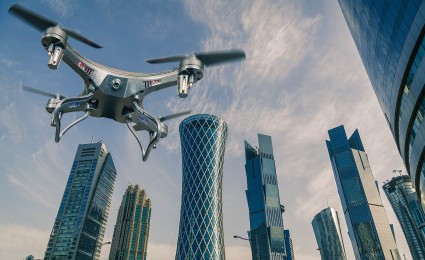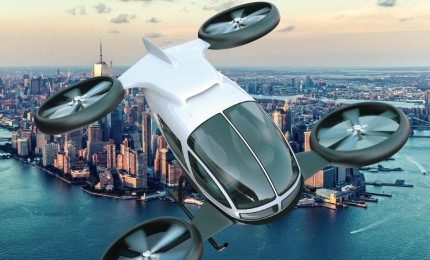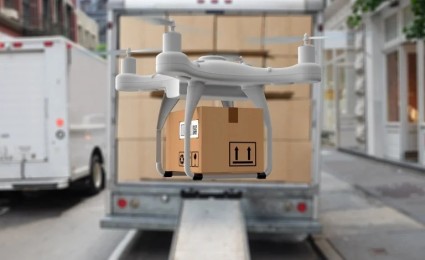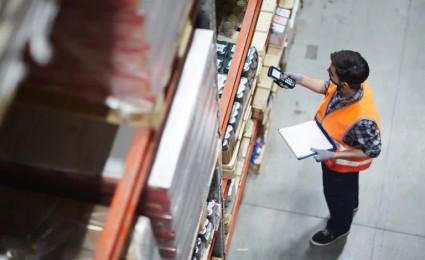

Designing urban logistics for the future
External author: Professor Achim Kampker, RWTH Aachen
How integrated IT platforms can increase efficiency in the logistics sector
Urban logistics is more dynamic than ever before: Our cities are growing; we're ordering TVs, pizza and even our sofa online; sensors can tell when recycling containers need to be emptied; new demands from online shoppers, such as for fast and flexible delivery, are increasingly being copied by local companies and even the restaurant trade. Every month a new startup surprises us with innovative solutions for the delivery, collection or storage of goods. In short, logistics is increasingly influencing the evolution of the modern city.
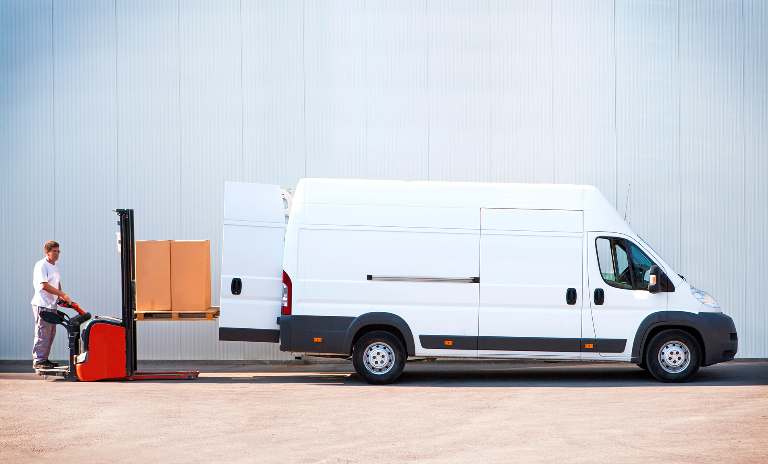
If we look at urban logistics as a complete system, one of the things we find is that goods deliveries are growing increasingly complex while the efficiency of the logistics network is actually declining. Established and up-and-coming providers alike are increasingly making direct deliveries, and average vehicle loads as well as consignment sizes are falling as a result. In three out of ten cases, direct delivery to consumers is unsuccessful at the first attempt, and the number of complex and expensive return consignments is steadily on the rise too. All of this ultimately leads to larger vehicle fleets and a bigger environmental impact.
At the same time, sensor technology or dynamic route optimization are not being used enough to enable logistics firms to switch from delivering along fixed routes to flexibly making the trips that are actually necessary. And though experts, trade associations and logistics providers may publicly profess that cooperation is a key driver of innovation in urban logistics, what we find in reality is that ambitious projects involving numerous participants far too often fail to get beyond the test stages. There are many ideas circulating on new technologies and concepts and various schemes being trialed, such as decentralized warehouses or aggregating goods flows, but there's been no scaling so far: Urban logistics today functions the same way as it did decades ago – only the volumes are significantly larger now, and they are steadily growing.
Whether logistics in our cities could be better organized is one of the central questions occupying minds in the sector. An analysis by Civitas, a network of European cities, calculated that there are between 300 and 400 goods transports per 1,000 people per day. And that has consequences. In Germany, for example, almost one fifth of city-center, traffic-related NO2 emissions are attributable to commercial vehicles, according to figures from the Federal Environment Ministry. But beyond the issue of environmental damage, logistics companies are constantly looking for ways to improve their business, despite record volumes, due to the chronically low margins in the industry.
We are convinced that if it were possible to pool the innovation capacity of all urban logistics players, the sector would be able to tap a huge amount of efficiency potential. Central to this is the genuine integration of the system – initiated and controlled by a city that is actively shaping its evolution.
The key to a solution: Thinking of urban logistics as a whole
Let's imagine how it would work: A city builds an ecosystem in which the various logistics players are all interconnected with one another. Three things are necessary for that to happen. 1) All relevant market participants – from large carriers to bicycle couriers – record their delivery capacities in a central IT platform. 2) This platform makes it possible to establish digital, physical and operational connectivity between the players and to control their actions. 3) All of the involved parties agree on certain IT standards, and ideally on shipment sizes that are modular so that they can be flexibly combined to enable the interconnection of the different parties to run smoothly.
A central platform of this kind would therefore know all of the transport capacities available in the city – in real time and, what's more, in advance. If you then feed demand into this system, you hold the key to enabling efficiency gains in the logistics sector. The ideal transport capacity would be assigned to each consignment – whether large and planned in advance or small and last minute. Established parcel delivery companies would be just as much a part of this system as taxis doing courier trips or trucks delivering to retailers, which instead of returning empty could collect cardboard packaging for recycling. With actual traffic planned in real time, it becomes possible to manage daily flows and also to react to additional volumes or any disruptions. And this maximum conceivable transparency around supply chains means that the urban logistics network will genuinely be as efficient as it can be.
That may sound utopian. But the real-life success of this kind of approach involving an intricately interconnected logistics ecosystem is demonstrated not just by the numerous startups operating through platforms but even more so by the behemoth that is Amazon. The American retail, technology and logistics giant has built up an infrastructure that enables it to determine and accurately forecast all of its logistics demand in real time. Amazon has an exact overview of its value chain at all times and builds its own urban supply chains wherever it can't rely on partners to meet the standard it requires. However, the Amazon system only works where there are sufficient volumes along with prespecified size and delivery standards. Because Amazon does not accept any external volumes, the system is limited geographically and in terms of type of goods. But even that is changing: Since the end of June 2020, Amazon has also been picking up and delivering parcels for third parties in the UK – and it's to be expected that this model will be rolled out internationally.
"City authorities create space for urban logistics."
The big question: Won't system integration just create a monopoly?
With any call for an integrated system, people might get the impression that it's really about establishing a monopoly. The idea is tempting, for sure: A company (say, DHL, Alibaba or Siemens) would organize the city and offer all the players the best service that the use of artificial intelligence could provide, and at low cost – because no system can be as efficient as the one that really controls all the capacity.
But urban logistics as the engine for the city of the future must offer more than just efficiency. It needs to be available at the same high quality even in less densely populated areas, be low-emission in every respect, offer fair working conditions and much, much more. Besides that, ongoing investment will be needed to ensure that the market retains its power to innovate and that new technologies can be put to use quickly.
That is exactly what's wrong with any system solution provided from a single source. Either we'd have a monopoly created by the sheer superiority of a single company – a situation that has never been known to lead to a balance of interests. Or we'd have the state regulating the system by awarding regional monopolies on a contract basis – as is repeatedly being demanded, along the lines of what happens with rail passenger transportation in Germany – which means that the only investment that would go into the system is what was agreed upon at the start of the contract. The result: Genuine innovation grinds to a halt.
So, if a monopolistic platform is not desirable, we need to ask: Is there still a way to facilitate the creation of deep system integration that will permanently increase the efficiency of urban networks? And how can requirements beyond profitability be taken into account while at the same time maintaining competition within the system?
Our suggestion: Qualified companies establish several platforms
The idea behind this is simple: The city authorities create space for urban logistics and grant access to this space to selected companies that meet certain requirements.
Three examples of how cities could create an attractive offer for logistics companies:
- Parcel lockers, where customers can pick up or drop off parcels themselves, increase planning reliability and reduce transport costs for parcel delivery firms. The problem is the lack of space for this to be offered truly across the board. Logistics companies negotiate with gas stations, supermarkets or large firms to get access to locations that wouldn't take users too far out of their way.
City authorities could provide space to enable a very dense network of parcel lockers, accessible to all delivery firms. Space occupied by the municipal transportation companies at stations, for example, would be ideal for this purpose. In many places, sidewalks also have enough space to add hundreds of pieces of "street furniture" at a stroke. - Urban consolidation centers to which all logistics companies have access make it possible to aggregate shipments and deliveries within city centers. Electric vehicles, especially tricycles, can be used for the very last mile, these last meters, thus facilitating short delivery routes with a high stop density.
Cities could purchase space, especially on the outskirts of densely populated urban centers, and rent it out as consolidation centers; or they could reserve parking spaces for temporary solutions (even just by the hour, depending on the location). This would also make it easier for retailers in pedestrianized zones to organize their delivery traffic during the day. - For delivery vehicles, double-parking or parking at intersections is seen by many drivers as unavoidable, but it is against the law in most countries. There are some exceptions, though: In Germany, taxis are allowed to stop as long as they're not obstructing anybody, and in Spain, parking is usually not punished if the hazard warning lights are at least on.
City authorities could designate parking spaces for delivery vehicles and impose stricter sanctions for double-parking.
On principle, only selected companies would be granted access to this new infrastructure. And they would explicitly not be chosen based on the lowest price. Instead, municipal or state authorities would prequalify those logistics companies that had a platform on which, as outlined above, a diverse range of transport capacities could be organized and pooled. Because it can be assumed that several logistics providers would prequalify, these platforms would then be in competition with each other. As such, no one would be excluded from participating in the newly created opportunities. Every company could then either achieve qualification itself or organize its offer via one of the platforms.
The authorities could attach a number of conditions to prequalification. Perhaps certified companies would have to provide the same offer in both densely and less densely populated areas. Or perhaps permission to operate in certain areas would be tied to the use of environmentally friendly vehicles such as electric cars or electric bikes. Pricing and quality standards for customers could also be among the criteria.
From a legal perspective, it would also be easier and quicker for a city to actively shape the system in this way than it would, for instance, by introducing a licensing system like we have for cab drivers or pharmacists. That said, the latter is indeed being proposed for innovations in other parts of the transportation sector : The mobility startup Goggo Networks, for example, is calling for a licensing system for autonomous driving to protect the European market from the supremacy of providers such as Waymo, Uber or Apollo from China, who, with the slogan "The Amazon of Transport Services" of all things, are pursuing their vision of an all-powerful platform.
"The central element is the genuine integration of the complete system."
The effects: Pooling and innovation will bring efficiency gains
As outlined in the vision of an integrated system solution laid out above, there is significant scope to increase the efficiency of urban logistics. This can be achieved by pooling, whereby the overall system makes much more consistent use of positive effects than is possible within the current isolated solutions. Specifically:
- The stop density and shipment volume per stop are increased because there are no longer several delivery firms delivering at the same time in the same part of town, on the same street or to the same house
- Half-empty vehicles can be filled up while driving a route, including with deliveries ordered at short notice
- Urban consolidation centers can be used in city centers to aggregate consignments over the very last meters
- Mixed use of vehicles is enabled. For example, a vehicle that delivers parcels during the day could be used for security patrols at night and to deliver newspapers in the morning, or to transport recycling materials at the end of a delivery route. Effectively creating a fleet used by everyone.
- Third-party vehicles can be integrated into the logistics network, including taxis or ride hailing
- Efficient same-day or next-hour deliveries can be achieved through improved transparency and higher volumes
- Routes are optimized to facilitate consolidation and integration through exact knowledge and incisive prediction of goods flows.
In addition to this, the hurdle of having to prequalify could trigger, or even demand, innovation. The requirement may be that the only firms who could qualify for access to the new infrastructure would be those that consistently applied innovations above and beyond the mere pooling offered by platforms and were creating an increasingly smart system. Examples include:
- Use of low-emission vehicles of various sizes, depending on actual requirements, including automated solutions such as Ducktrain or vehicles that follow the delivery person
- Consistent use of parcel lockers to aggregate deliveries and thus reduce failed delivery attempts, even for products that need to be chilled, such as food or medicine
- Better service quality, e.g. up-to-the-minute track and trace for recipients, returns direct to the delivery person, last-minute booking of collections, all made possible by the transparency of the platform – even going as far as the implementation of the Physical Internet
- Night-time deliveries, which can facilitate transport time gains and help equalize traffic flows
- Inventory optimization and reduction of warehouse sizes through open interfaces and the sharing of information with retailers and suppliers.
Translated into measurable factors, this means:
- Less emissions by switching to low-emission vehicles, e.g. rapid reduction of CO2 and pollutant emissions by 30 percent through improved efficiency when in neutral and at a standstill, as well as recuperation (in the current electricity mix; later there will be the possibility to realize the vision of completely emission-free deliveries)
- Fewer and more precisely suited vehicles and less space required, with corresponding cost reductions and lower capital employed: Savings of at least 20 percent through sharing in parcel delivery alone; additional effects through multifunctional use
- Fewer vehicle kilometers for a given level of transport demand, resulting in less traffic combined with cost savings. Experience from numerous network integration schemes shows that effects of 10 to 30 percent, sometimes more, are possible.
"Piloting new schemes under real-life conditions is a key success factor."
The road ahead: Three steps to a new urban logistics
The first step, as we see it, is to define the functional and legal framework for prequalification. This includes specifications for determining the necessary scale, defining incentive systems to encourage the reduction of energy and space requirements, and defining indicators by which to measure efficiency and quality improvements. In addition, cities should determine what infrastructure can be specifically included in the model.
Then three regions should be chosen as real-life test labs, e.g. the center of a large city, the outskirts of a large city and a medium-sized city, to test the principles that have been described, evaluate experience and, in particular, refine the contracting framework over a period of one to two years.
Finally, in a third step, the new urban logistics concept should be rolled out nationwide.
We know that what we are proposing is no mean feat. But the complexity and the importance of urban logistics will only continue to grow. Actively designing urban logistics for the future seems to us to be exactly what's needed right now.
This publication was produced in cooperation with RWTH Aachen University.
RWTH University Professor
Dr.-Ing. Achim Kampker MBA
Chair of Production Engineering of E-Mobility Components





